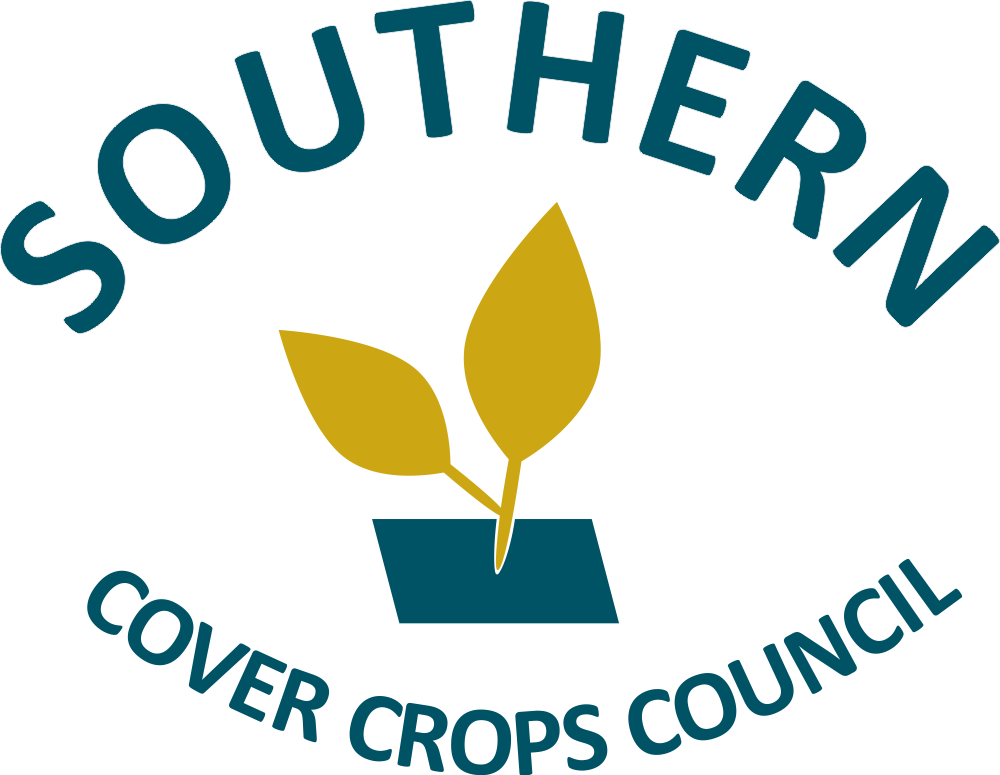Termination with Herbicides
Most commonly grown cover crops can be controlled very effectively with herbicides but one must consider the following: cover crop species and growth stage, the following cash crop (herbicide crop rotation restriction), weeds that are growing in the cover crop or that may grow in the following cash crop, the weather, and the proper herbicide(s) and use rate(s).
The most common herbicides used to terminate cover crops are broad-spectrum. That is, they will kill all types of plants—grasses and broadleaves. Examples are glyphosate, glufosinate and paraquat. Note that some cover crop species have a natural tolerance to some broad spectrum herbicides, especially at certain growth stages like during stem elongation and the late flowering period. In these cases, timing of herbicide applications is key. Other herbicides are selective; that is, they only will kill specific types of plants, like grasses or broadleaves. The use of selective herbicides is often recommended for terminating some species of cover crops. For example, growth regulator herbicides (i.e. dicamba and 2,4-D) are selective broadleaf herbicides. They will not kill grasses, but their inclusion in an herbicide mixture can improve the control of legume cover crops. Generally, tank-mixtures of broad-spectrum and selective herbicides are allowable based on the product label and can improve cover crop termination. However, the mixture of some selective herbicides can actually reduce their effectiveness (antagonistic), so applicators are encouraged to carefully read the relevant sections of product labels on tank-mixing and check with their local Extension service for more information.
Glyphosate, paraquat, glufosinate, 2,4-D, and dicamba applied alone or in various combinations are commonly used as burndown herbicides to control cover crops and emerged winter weeds. Herbicides such as flumioxazin, diuron, or atrazine are often included with the burndown herbicides to improve control of emerged weeds depending on the cash crop being planted. These products also provide residual control and can help prevent troublesome weeds during planting the cash crop. One of the most important steps for successful weed management is making sure problematic weeds such as Palmer amaranth or annual ryegrass are not present when planting the cash crop.
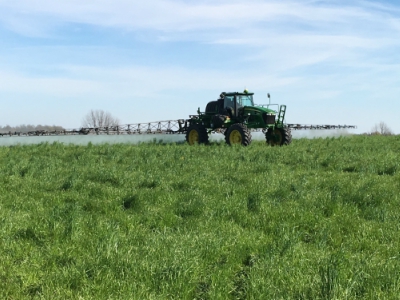 Achieving maximum activity from an herbicide is dependent on applicators making wise decisions. Factors influencing coverage such as gallons per acre (GPA), spray pressure (PSI), spray nozzle type, tractor speed, boom height, and wind speeds must be understood and followed to maximize on-target pesticide applications and protect applicators, farmers, consumers, and the environment. Keep in mind any adjuvant needs for these herbicides. The use of a non-ionic surfactant is required for adequate paraquat activity and for some formulations of glyphosate. For each herbicide, refer to the label for best management practices to follow.
Achieving maximum activity from an herbicide is dependent on applicators making wise decisions. Factors influencing coverage such as gallons per acre (GPA), spray pressure (PSI), spray nozzle type, tractor speed, boom height, and wind speeds must be understood and followed to maximize on-target pesticide applications and protect applicators, farmers, consumers, and the environment. Keep in mind any adjuvant needs for these herbicides. The use of a non-ionic surfactant is required for adequate paraquat activity and for some formulations of glyphosate. For each herbicide, refer to the label for best management practices to follow.
In addition to proper herbicide application, understanding how herbicides move or don’t move through plants can be beneficial. Some herbicides are systemic—they move throughout the plant in the vascular system. Systemic products like glyphosate, 2,4-D or dicamba are extremely effective when applied using large droplets, which reduce off-target drift while still maximizing weed control. Contact herbicides often only affect tissues where they make direct contact—they do not usually move throughout the plant. Paraquat and glufosinate are two examples of “mostly” contact herbicides in which the applicators must achieve excellent coverage on the entire plant. This means that high spray volumes (> 15 gallons per acre) and often medium droplets should be used to target small plants. Dense, complex canopies of vegetation, such as those resulting from some cover crop mixtures, may not be well-controlled by these contact herbicides when used alone, although there are exceptions such as paraquat and mature rye.
Before applying any herbicide, weather must be considered. Many burndown herbicides do not function well under cool (especially cold) temperatures or during dry periods. For example glyphosate requires days over 55 oF and nights over 40 oF, although for optimal activity weather conditions would be much warmer. Other herbicides, like glufosinate, require warm days (ideally >80 oF) and need to be applied during the middle of the day, when the sun is high in the sky, to be most effective. Also, rainfall too soon after applying herbicides can negatively influence an herbicides activity. Growers are cautioned to pay close attention to the weather conditions when planning their termination applications.
Plant back intervals, or the time between an herbicide application and planting of the cash crop, must be considered when using nearly all herbicides with the exception of glyphosate, glufosinate, and paraquat. For example, the plant back time for 2,4-D in soybeans is 28 days. Always follow the requirements on the herbicide label. Please check your Extension row crop weed control guide for these plant back restrictions.
Most cover crop species will have an optimum growth stage for herbicide termination. In addition, some cover crop species will respond differently to selective and broad-spectrum herbicides.
Use the guide below for a broad look at herbicide selection based on your species, but consult your local Extension agent for guidance in particular situations:
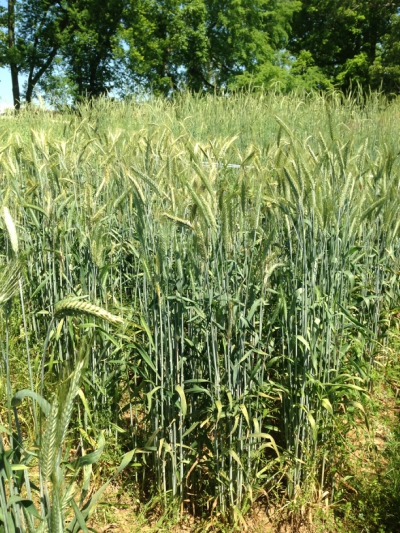 Small grains: Small grains are usually easily terminated with a broad spectrum herbicide like glyphosate. Glyphosate is most effective when applied before the boot stage and again once seedheads are visible. Between the boot stage and seedheads being visible, ideal temperatures and maximum rates are often needed for success. Increase spray volume, and adjust boom height for taller, lush or dense stands of cereal rye or other small grains. If tank mixtures are used, be knowledgeable about when the tank mix partner improves or reduces control. For example, mixing diuron with glyphosate will improve control of many winter weeds, but often reduces control of wheat when compared to glyphosate applied alone. Paraquat may work better when applied after the boot stage or prior to jointing, when plants are still relatively small. If paraquat is used, include a triazine (like metribuzin) to increase effectiveness. Paraquat is rarely as effective as glyphosate except when the small grain contains mature seeds.
Small grains: Small grains are usually easily terminated with a broad spectrum herbicide like glyphosate. Glyphosate is most effective when applied before the boot stage and again once seedheads are visible. Between the boot stage and seedheads being visible, ideal temperatures and maximum rates are often needed for success. Increase spray volume, and adjust boom height for taller, lush or dense stands of cereal rye or other small grains. If tank mixtures are used, be knowledgeable about when the tank mix partner improves or reduces control. For example, mixing diuron with glyphosate will improve control of many winter weeds, but often reduces control of wheat when compared to glyphosate applied alone. Paraquat may work better when applied after the boot stage or prior to jointing, when plants are still relatively small. If paraquat is used, include a triazine (like metribuzin) to increase effectiveness. Paraquat is rarely as effective as glyphosate except when the small grain contains mature seeds.
Annual ryegrass: Annual ryegrass termination can be difficult. It has a very narrow interval during which herbicides are effective. Ryegrass has essentially developed resistance to every effective herbicide mode of action commercialized. This makes cover crop termination critical before viable seeds are produced. Using the same herbicide mode of action on a ryegrass population producing seeds for three years in a row will likely lead to resistance.
Higher rates of glyphosate applied at early flower is the best control option. However, in fields where termination may be a problem, applying glyphosate followed by paraquat 5 to 7 days after the glyphosate is advised. Maximum glyphosate and paraquat rates are usually needed. Consult local Extension for recommended rates. Annual ryegrass is very sensitive to weather conditions after application, and requires at least 2 to 3 days with temperatures > 55o F for adequate termination.
Because of this short interval to terminate annual ryegrass, it is important to plant just one variety of annual ryegrass seed. This ensures that all plants will mature at the same time. If a mixture of varieties is planted, some plants in the field may be at the optimum termination growth stage while others are not yet ready. The immature variety will not be killed by the herbicide application timed to terminate the more mature flowering variety. In addition, it may be worth asking your seed dealer if the seed producers reduce the chance of contamination with the weedy relative – Lolium rigidum – by producing seed only on clean fields.
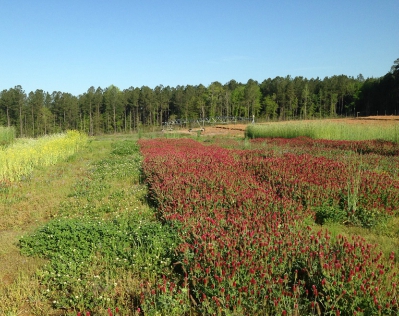 Legumes: Broad-spectrum herbicides such as glyphosate and paraquat alone will not generally be effective for termination of legume cover crops; however, broad-spectrum herbicides should be included in the tank mixture to control weeds that may be in the cover crop stand. Tank mixtures of glyphosate and paraquat with auxin herbicides (dicamba or 2,4-D) or triazine/substituted urea herbicides (like metribuzin, atrazine or diuron depending on cash crop) can be effective. Consult your local Extension agent for guidance in particular situations.
Legumes: Broad-spectrum herbicides such as glyphosate and paraquat alone will not generally be effective for termination of legume cover crops; however, broad-spectrum herbicides should be included in the tank mixture to control weeds that may be in the cover crop stand. Tank mixtures of glyphosate and paraquat with auxin herbicides (dicamba or 2,4-D) or triazine/substituted urea herbicides (like metribuzin, atrazine or diuron depending on cash crop) can be effective. Consult your local Extension agent for guidance in particular situations.
See below for general recommendations based on legume type:
- Red and white clovers: glyphosate plus dicamba or 2, 4-D
- Crimson clover: glyphosate plus dicamba before bloom
- Hairy vetch: 2,4-D plus glyphosate
- Field peas: glyphosate
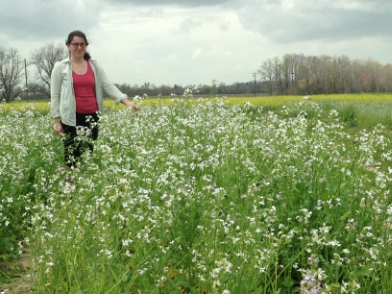 Brassicas: Glyphosate plus 2,4-D is often the most effective option. Multiple applications may be necessary if no tillage will be used. Rapeseed can be particularly hard to terminate when it is large; consequently, it should be planted in combination with other well-adapted cover crops to increase intra-cover crop competition and keep the plants small.
Brassicas: Glyphosate plus 2,4-D is often the most effective option. Multiple applications may be necessary if no tillage will be used. Rapeseed can be particularly hard to terminate when it is large; consequently, it should be planted in combination with other well-adapted cover crops to increase intra-cover crop competition and keep the plants small.
Winter cover crop mixtures: A more complex herbicide tank-mixture will likely be necessary to kill cover crop mixtures. While tank-mixing increases the cost of a burndown application, it has also been shown to be a very effective tool in managing the evolution and spread of herbicide resistant weeds. Prior to tank-mixing, growers are advised to read the relevant portions of the component herbicide labels, or to consult their local extension on compatible tank mix products.
Summer cover crops: Summer cover crop will frost kill. Herbicides can be used to terminate these cover crops earlier.
Terminating cover crops vs. applying herbicides to the cash crop: There is temptation to tank-mix the cover crop termination herbicides with the residual herbicides that will prevent weeds from emerging in the following cash crop. Timing of termination relative to cash crop planting will have a large influence on whether this is advisable. If cover crops are terminated early relative to cash crop planting, the impact of these residual herbicides may dissipate by the time the cash crop is planted. Keep in mind one of the keys to a successful cash crop is making sure problematic weeds are not present at planting; consequently, a residual herbicide may be extremely effective in reaching this goal if it reaches the soil and is activated. There is concern that if residual herbicides are applied in high-residue cover crops, poor soil contact may potentially result in poor weed control. Residual herbicides are still recommended for better weed management in general, but particularly if there are gaps in the cover crop residue. For best results, roll the cover crop before herbicide application to allow the residual herbicide to reach the soil in any gaps.
The herbicide application rate, application method, tank mixes, and planting restrictions vary for different products. Always read the product label and consult your local Extension agent or the pest management handbook for your state for guidance.
More Information:
- A Simple Guide for Conservation Systems in the Southeast. USDA ARS
- Termination of Cover Crops: Management Considerations for the Subsequent Cash Crop. Conservation Systems Fact Sheet No. 11. USDA ARS
Contributors:
Dr. Charlie Cahoon, Extension Specialist, Virginia Tech; Dr. Stanley Culpepper, Extension Specialist, University of Georgia; Dr. Mike Flessner, Extension Specialist, Virginia Tech; Julia Gaskin, Extension Specialist, University of Georgia; Dr. Erin Haramoto, Assistant Professor, University of Kentucky; Dr. Andy Price, USDA Agricultural Research Service; Dr. Mark Reiter, Extension Specialist, Virginia Tech; Dr. William Vencill, Professor, University of Georgia
